Questões de Concurso
Para unicamp
Foram encontradas 744 questões
Resolva questões gratuitamente!
Junte-se a mais de 4 milhões de concurseiros!
O circuito a seguir possui um voltímetro e um amperímetro, ambos considerados ideais. R2 = 1 Ω e R4 = 3 Ω.
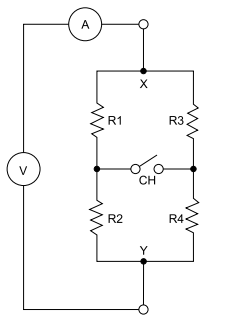
Foram efetuadas medições em duas condições:
• CH aberta: leitura do voltímetro = 6 V, leitura do amperímetro = 2 A.
• CH fechada: leitura do voltímetro = 6 V, leitura do amperímetro = 2 A.
Nessas condições, tem-se que
Deseja-se construir um circuito divisor de tensão com as seguintes características:
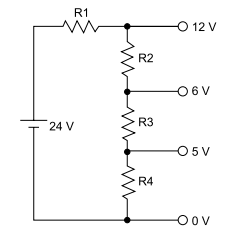
Sabendo-se que R2 = 150 Ω, tem-se que:
Em uma residência encontra-se instalado um chuveiro elétrico de potência igual a 2200 W, alimentado por uma tensão de 220 V. Considerando que esse tenha sido o único equipamento a consumir energia elétrica na residência em um período de 30 dias, a conta de energia mensal, devido ao seu uso, foi de R$ 49,50, sendo que o custo do kWh é igual a R$ 0,50.
Sobre essa situação, é correto afirmar que
1. What is an analog-digital converter?
An Analog-Digital Converter (ADC) is a widely used electronic component that converts an analog electric signal (usually a voltage) into a digital representation. The ADCs are at the front-end of any digital circuit that needs to process signals coming from the exterior world. Its schematic symbol is:

The output of a microphone, the voltage at a photodiode or the signal of an accelerometer are examples of analog values that need to be converted so that a microprocessor can work with them.
2. How does the ADC convert a signal?
Many ways have been developed to convert an analog signal, each with its strengths and weaknesses. The choice of the ADC for a given application is usually defined by the requirements you have: if you need speed, use a fast ADC; if you need precision, use an accurate ADC; if you are constrained in space, use a compact ADC.
All ADCs work under the same principle: they need to convert a signal to a certain number of bits N. The sequence of bits represents the number and each bit has the double of the weight of the next, starting from the Most Significant Bit (MSB) up to the Least Significant Bit (LSB). In a nutshell, we want to find the sequence of bits bN−1, bN−2, ..., b0 that represents the analog value Vin as Vin=∑n=0N−1bn2nVref2N.
(www.onmyphd.com/?p=analog.digital.converter. Adaptado)
No trecho da resposta à segunda pergunta – In a nutshell, we want to find the sequence of bits…–, a expressão destacada equivale, em português, a
1. What is an analog-digital converter?
An Analog-Digital Converter (ADC) is a widely used electronic component that converts an analog electric signal (usually a voltage) into a digital representation. The ADCs are at the front-end of any digital circuit that needs to process signals coming from the exterior world. Its schematic symbol is:

The output of a microphone, the voltage at a photodiode or the signal of an accelerometer are examples of analog values that need to be converted so that a microprocessor can work with them.
2. How does the ADC convert a signal?
Many ways have been developed to convert an analog signal, each with its strengths and weaknesses. The choice of the ADC for a given application is usually defined by the requirements you have: if you need speed, use a fast ADC; if you need precision, use an accurate ADC; if you are constrained in space, use a compact ADC.
All ADCs work under the same principle: they need to convert a signal to a certain number of bits N. The sequence of bits represents the number and each bit has the double of the weight of the next, starting from the Most Significant Bit (MSB) up to the Least Significant Bit (LSB). In a nutshell, we want to find the sequence of bits bN−1, bN−2, ..., b0 that represents the analog value Vin as Vin=∑n=0N−1bn2nVref2N.
(www.onmyphd.com/?p=analog.digital.converter. Adaptado)
1. What is an analog-digital converter?
An Analog-Digital Converter (ADC) is a widely used electronic component that converts an analog electric signal (usually a voltage) into a digital representation. The ADCs are at the front-end of any digital circuit that needs to process signals coming from the exterior world. Its schematic symbol is:

The output of a microphone, the voltage at a photodiode or the signal of an accelerometer are examples of analog values that need to be converted so that a microprocessor can work with them.
2. How does the ADC convert a signal?
Many ways have been developed to convert an analog signal, each with its strengths and weaknesses. The choice of the ADC for a given application is usually defined by the requirements you have: if you need speed, use a fast ADC; if you need precision, use an accurate ADC; if you are constrained in space, use a compact ADC.
All ADCs work under the same principle: they need to convert a signal to a certain number of bits N. The sequence of bits represents the number and each bit has the double of the weight of the next, starting from the Most Significant Bit (MSB) up to the Least Significant Bit (LSB). In a nutshell, we want to find the sequence of bits bN−1, bN−2, ..., b0 that represents the analog value Vin as Vin=∑n=0N−1bn2nVref2N.
(www.onmyphd.com/?p=analog.digital.converter. Adaptado)
1. What is an analog-digital converter?
An Analog-Digital Converter (ADC) is a widely used electronic component that converts an analog electric signal (usually a voltage) into a digital representation. The ADCs are at the front-end of any digital circuit that needs to process signals coming from the exterior world. Its schematic symbol is:

The output of a microphone, the voltage at a photodiode or the signal of an accelerometer are examples of analog values that need to be converted so that a microprocessor can work with them.
2. How does the ADC convert a signal?
Many ways have been developed to convert an analog signal, each with its strengths and weaknesses. The choice of the ADC for a given application is usually defined by the requirements you have: if you need speed, use a fast ADC; if you need precision, use an accurate ADC; if you are constrained in space, use a compact ADC.
All ADCs work under the same principle: they need to convert a signal to a certain number of bits N. The sequence of bits represents the number and each bit has the double of the weight of the next, starting from the Most Significant Bit (MSB) up to the Least Significant Bit (LSB). In a nutshell, we want to find the sequence of bits bN−1, bN−2, ..., b0 that represents the analog value Vin as Vin=∑n=0N−1bn2nVref2N.
(www.onmyphd.com/?p=analog.digital.converter. Adaptado)
1. What is an analog-digital converter?
An Analog-Digital Converter (ADC) is a widely used electronic component that converts an analog electric signal (usually a voltage) into a digital representation. The ADCs are at the front-end of any digital circuit that needs to process signals coming from the exterior world. Its schematic symbol is:

The output of a microphone, the voltage at a photodiode or the signal of an accelerometer are examples of analog values that need to be converted so that a microprocessor can work with them.
2. How does the ADC convert a signal?
Many ways have been developed to convert an analog signal, each with its strengths and weaknesses. The choice of the ADC for a given application is usually defined by the requirements you have: if you need speed, use a fast ADC; if you need precision, use an accurate ADC; if you are constrained in space, use a compact ADC.
All ADCs work under the same principle: they need to convert a signal to a certain number of bits N. The sequence of bits represents the number and each bit has the double of the weight of the next, starting from the Most Significant Bit (MSB) up to the Least Significant Bit (LSB). In a nutshell, we want to find the sequence of bits bN−1, bN−2, ..., b0 that represents the analog value Vin as Vin=∑n=0N−1bn2nVref2N.
(www.onmyphd.com/?p=analog.digital.converter. Adaptado)
A figura a seguir exemplifica alguns tipos de técnicas de amostragem aleatória de uma população.
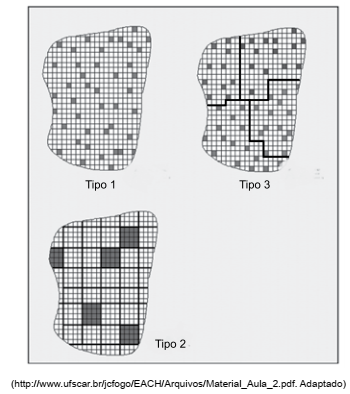
Os tipos 1, 2 e 3 correspondem, respectivamente, às
amostragens aleatórias
Considere as informações do gráfico.
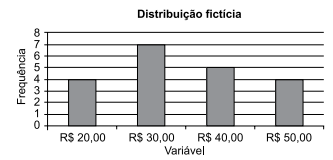
Com base nas informações apresentadas no gráfico, é
correto afirmar que
Um reservatório com formato interno de paralelepípedo reto retangular, com 3 metros de altura, está com 12,6 m3 de água, o que corresponde a três quintos do seu volume máximo. Sabendo-se que a diferença entre as medidas das arestas da base desse reservatório é de 1,5 metro, é correto afirmar que o perímetro da base desse reservatório mede
O gráfico a seguir consta do Boletim Regional do Banco Central do Brasil e apresenta informações sobre a Balança Comercial do Estado de São Paulo.
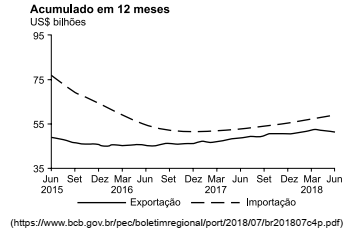
Considerando-se deficit a diferença negativa e superavit
a diferença positiva entre exportação e importação, nessa ordem, é possível concluir corretamente que
Considere 3 máquinas, A, B e C, que produzem o mesmo tipo de peça.
Certo dia, uma quantidade x dessas peças foi encomendada e, se essa quantidade fosse fabricada somente pela máquina A, ela levaria 6 horas para produzir todas as peças, trabalhando ininterruptamente; se toda a quantidade fosse fabricada pela máquina B, o serviço seria realizado em 7 horas de trabalho ininterrupto; se toda quantidade fosse realizada pela máquina C, o serviço seria realizado em 5 horas de trabalho ininterrupto. Levando-se em consideração o custo/benefício de produção em cada uma das máquinas, optou-se por dividir a produção da seguinte forma: a máquina C trabalhará por 2 horas e 15 minutos, de forma ininterrupta; a máquina A, 3 horas ininterruptas; e, na máquina B, serão fabricadas 2 mil unidades da peça. Sendo assim, o número de unidades de peças encomendadas é
Considere a seguinte informação, apresentada pela Companhia Nacional de Abastecimento (Conab), em 20 de novembro de 2018.
“O aumento no preço do tomate foi o grande destaque na análise das hortaliças nas principais Centrais de Abastecimento (Ceasas) do país. Desta vez, a elevação foi unânime e teve percentuais significativos, com maior alta de 145%, em Vitória (ES), seguida de 127% em Goiânia (GO) e 105% em Belo Horizonte (MG).”
(https://www.conab.gov.br/ultimas-noticias/2579-boletim-prohort-mostra-que-tomate-e-a-hortalica-com-maior-alta-de-precos)
Supondo que em Vitória, após essa informação, o tomate estivesse sendo vendido ao preço de R$ 3,92, é correto afirmar que, nesse preço, com base na informação dada, estaria embutido um aumentado de